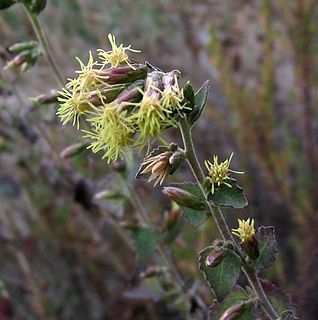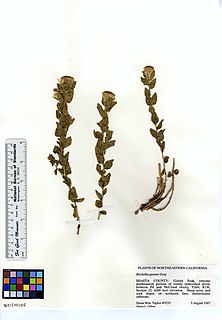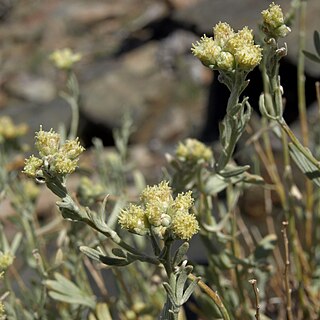Eriophyllum multicaule is a North American flowering plant in the family Asteraceae, known by the common name manystem woolly sunflower. It is native to California and Arizona in the southwestern United States.

Brickellia californica, known by the common name California brickellbush, is a species of flowering plant in the family Asteraceae.

Brickellia nevinii is a species of flowering plant in the family Asteraceae known by the common name Nevin's brickellbush. It is native to southern California and Nevada, where it is an uncommon resident of desert and mountain scrub plant communities.

Ambrosia eriocentra is a North American species of ragweed known by the common names woolly bursage and woollyfruit burr ragweed.

Antennaria flagellaris is a North American species of flowering plant in the family Asteraceae known by the common names whip pussytoes and stoloniferous pussytoes. It is native primarily to the Great Basin and Columbia Plateau regions of Washington, Oregon, Idaho, and northern Nevada, where it is a member of the sagebrush scrub plant community. Additional populations are found in northeastern California, Wyoming, the Black Hills of South Dakota, and the Canadian Province of British Columbia.

Antennaria luzuloides is a North American species of flowering plant in the family Asteraceae known by the common name rush pussytoes. The species is native to western Canada and the western United States.

Baileya pleniradiata is a North American species of flowering plant in the daisy family, known by the common name woolly desert marigold. It is native to desert regions of the southwestern United States and northern Mexico, where it grows in sandy habitats. It has been found in the States of Chihuahua, Sonora, Baja California, Arizona, Utah, and Nevada.
Brickellia arguta is a North American species of flowering plant in the family Asteraceae known by the common name pungent brickellbush. It is native to the Mojave and Sonoran Deserts of California, Nevada, Arizona, and Baja California.

Brickellia desertorum is a species of flowering plant in the family Asteraceae known by the common names desert brickellbush and desert brickellia. It is native to Mexico, Central America, the West Indies, and the southwestern United States.

Brickellia grandiflora, known by the common name tasselflower brickellbush, is a species of flowering plant in the family Asteraceae.

Brickellia greenei is a species of flowering plant in the family Asteraceae known by the common name Greene's brickellbush. It is native to the mountain ranges of southwestern Oregon and northern California, including the Cascades, the northern Coast Ranges, and Sierra Nevada.
Chaenactis parishii is a species of flowering plant in the daisy family known by the common name Parish's chaenactis.

Crepis intermedia is a North American species of flowering plants in the daisy family known by the common name limestone hawksbeard. It is native to the Pacific Northwest, Columbia Plateau, Great Plains and Southwestern regions of western North America.

Enceliopsis nudicaulis is a North American species of flowering plants in the daisy family known by the common name nakedstem sunray, or naked-stemmed daisy.
Eriophyllum ambiguum is a species of flowering plant in the family Asteraceae known by the common name beautiful woolly sunflower. It is native to the deserts and adjacent hills of southern and eastern California, northwestern Arizona, and southern Nevada.

Eriophyllum pringlei is a North American species of flowering plant in the family Asteraceae known by the common name Pringle's woolly sunflower. It is native to the southwestern United States and northern Mexico, where it grows in several types of desert, canyon, and hillside habitat, such as chaparral and sagebrush.

Dieteria canascens is an annual plant or short lived perennial plant in the daisy family, known by the common names hoary tansyaster and hoary-aster.
Psilocarphus elatior is a species of flowering plant in the family Asteraceae known by the common names tall woollyheads, meadow woollyheads and tall woolly-marbles. It is native to the Pacific Northwest in western North America from Vancouver Island, where it is known from just a few occurrences, to northern California. It grows in seasonally moist spots such as meadows, spring seeps, and vernal pools.

Sphaeromeria cana is a species of flowering plant in the family Asteraceae known by the common name gray chickensage. It is native to the western United States, where it is known from the Sierra Nevada, the adjacent desert ranges of eastern California and Nevada, and Steens Mountain of Oregon. It grows in dry, rocky mountain habitat, such as cracks and crevices, including the talus above the tree line. This is an aromatic subshrub with numerous erect branches growing up to 30 to 60 centimeters tall. It is gray-green in color and coated with woolly fibers. The leaves are linear or lance-shaped, the lower ones divided into lobes. The inflorescence is generally a cluster of flower heads lined with woolly phyllaries and containing yellow disc florets. There are no ray florets. The fruit is a ribbed achene about 2 millimeters long.
Stylocline citroleum is a rare species of flowering plant in the family Asteraceae known by the common name oil neststraw.














